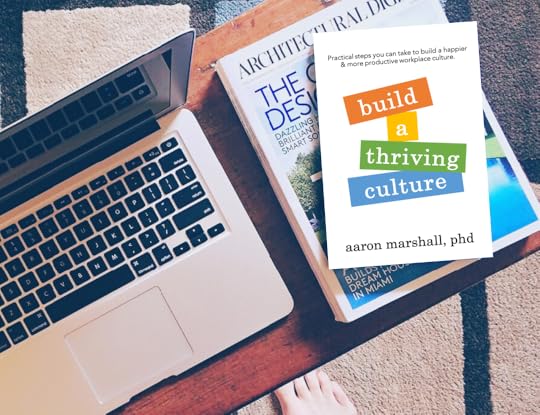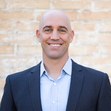A.R. Marshall's Blog
June 9, 2020
4 Winning Strategies for Staying Clear from the Top
Previous:
[image error]I'm sure you've noticed the correlation between clarity and expectations. Missed expectations lead to disappointment, frustration, and often disengagement.
Employees need leaders who are willing to be crystal clear.
And, clarity provides freedom to employees. When we know our role, we can own it. When employees own their role, they experience greater confidence and freedom. Thriving cultures depend on clarity - clear direction, clear purpose, and clear expectations.
If you want a thriving team, you'll need to get clear from the top. Here are four strategies to get you started immediately:
1. Draw out your hidden culture.
If you need convincing - YES, this is a real thing. Most organizations have two cultures: the one we think exists, and the one that really exists; the way people talk about behaving, and the hidden reality.
This gap between how you say work gets done and how it really gets done causes tangible harm to organizational culture. To close the gap, you’ll need to unearth the hidden culture and bring it into the light - get clear about how people actually get work done, and assess it.
If those "hidden" processes make sense, great - make them explicit. If not, make it clear to your team. Explain why those approaches are counter to your intended workplace culture.
2. Talk about alignment.
Just like your tires and your back might need regular adjusting, alignment requires regular attention. As a leader, alignment starts with communication. Beyond communicating clearly, you'll want to work with your teams. Make sure folks have clear goals. Make sure roles and responsibilities are explicit.
This will be especially difficult if your self-awareness slips. Knowing your own preferences and triggers will help you create safe space for the tough conversations you'll need to establish and maintain proper alignment.
3. Over-communicate change.
Change is hard. Change is personal.
When things change, it’s your job to provide (or keep providing) trust, stability, compassion, and hope. Get creative. Look for tangible ways to bring these four qualities to life in your organization through strong, empathetic, over-communication.
4. Create safe feedback loops
Finally, you'll need to flip “staying clear from the top” upside down. Feedback loops give you the power to listen. They offer the information you most need - as a leader - to maintain clarity within your organization.
Spoiler alert - listening alone won’t open safe feedback loops. How do you make those feedback loops safe? When is anonymity appropriate? When is it better to have one on one discussions or group standup meetings? If you want employees to share up, you've got to make it safe. As the leader, that's your responsibility.
So, that's it - get rid of the hidden culture, get aligned, over-communicate, and secure positive feedback loops. Piece of cake, right?
Leaders in thriving cultures practice being crystal clear. Every. Single. Day.
Are you ready to join them?
Next: 7 Authentic Ways to Accelerate Trust
June 8, 2020
Resistance & turning Pro: Change Log, Days 50-56

Wk 8: ,5 runs, 5 walks / ran 23.5km / 5k in 22:15
A few weeks ago, my brother-in-law and I sat down to watch a Hulu original called 11.22.63, based on a book written by Stephen King. English teacher Jake Epping finds himself traveling in time to stop the JFK assassination. His time traveling mentor, Al, repeatedly warns Jake: the past pushes back – it resists change. It’s been 56 days since I committed to daily exercise and I affirm Al’s warning.
Our past pushes back. It resists change.
If you’ve been following my daily exercise commitment, you'll remember that our family has effectively been living with my in-laws since Mother’s Day weekend. It’s been a gift to be with family during this difficult season – a gift to work remotely, to serve family well, and to journey this challenge with our kids.
It’s also been relatively easy to get up each day and walk or run – a sacred time for my mind to rest, wrestle, and process. There have been days across the last fifty where I didn’t want to exercise – sore legs, a packed schedule, failure to go early in the morning, and no desire to run in triple digit heat.
Even in those tougher days, however, the decision to exercise didn’t feel like a choice. I run or walked because I needed it. Sanity dictated I would exercise.
Week 8 started in similar fashion. It opened with my birthday. Eager to attack year forty-four with my own vision for a bigger life, I ran my fastest 5k to date. I ran on air and adrenaline. It felt great.
Day two I got my run in early. The day was full of meetings, and when it all ended, I loaded up the car. My eldest and I were heading home for a few days. We didn’t want to miss his sixth-grade promotion – apparently that has become a thing since I was in sixth grade – and despite COVID restrictions, we wanted him to be as present as possible with his peers.
Wednesday I said no to a morning run. Then, the day got busy – preparing for promotion, my own work and work meetings, his promotion zoom call, and evening plans to celebrate with friends (socially distanced, of course). Afternoon turned to evening - still no time for exercise.
Resistance prowled. I readied my own excuses.
Early in the War of Art, Steven Pressfield writes,
"Most of us have two lives. The life we live, and the unlived life within us. Between the two stands Resistance."
He goes on to personify this Resistance as the barrier to becoming who we are called to become. That unlived life within yearns to break out – but for Resistance.
I plowed through the War of Art this week, and enjoyed Pressfield’s no bull, nearly mystical approach to getting on with living our unlived life within.
Back to that evening, with a tight window between "now" and "pizza celebration," I told my son we needed to get some exercise.
He gave me that, “you can’t be serious” look. I said, "Please?" He gave in. with a nod. The ask, wasn’t easy. I didn't want to exercise, and neither did he.
,More than that, I didn't want the momentum to end - so I asked. Fifty-one days of consecutive exercise felt substantial. I didn't want it to end.
It was just a 25 minute walk, but it counted. I logged my 20 minutes of daily exercise.
More than that, it opened a beautiful moment for the two of us. As we walked, we talked - about his elementary career, his reflections and dreams, his fears about junior high.
The best part? After a few minutes of walking side-by-side, he grabbed my hand. Yep. You read that right. My sixth grade son grabbed my hand while we walked around our neighborhood. I melted. We talked. Hand in hand.
Pushing through day 52 gave me renewed energy for the days 53-56. Momentum steadied me against Resistance.
The next morning, I ran another 5k, and when the week closed I had logged my more kilometers (23.5) than any prior week. ,My back's not sore. My knees are holding up. This one-day-at-a-time commitment is changing me, even in the face of Resistance.
For Pressfield, we overcome Resistance by turning professional. Later in the War of Art he writes, “the professional is prepared each day to confront his own self-sabotage…his goal is not victory, but to handle himself, his insides, as sturdily and steadily as he can.”
The professional is becoming grounded, and in that grounded-ness he finds increasing self-awareness and strength. I think Pressfield is right about this. In our professionalism – in that grounded strength – our unlived life within can awake.
I know mine is waking. It wakes a bit more each day – as momentum builds, alongside confidence, self-awareness, and strength to handle myself – “as sturdily and steadily” as I can.
What about you? Are you living your unlived life within? If not, what's holding you back?
June 4, 2020
4-Step Process for Getting On Mission Together

Previous:
Building a thriving culture begins with getting a group of people - your people - on mission together. Accomplishing this task will not require a cape or mask.
You don’t have to be a superhero. You do have to be a leader.
You'll need to lead with a fierce will for your mission, high social/emotional intelligence, and a healthy measure of humility. Leaders with these characteristics are ready to listen, desire collaboration, grow relationships, and inspire greatness.
Step 1: Honor the past.
Everyone on your team has a history - full of wins and struggles, joy and pain. Getting that history on the table - inviting folks to acknowledge their past experiences, and articulate their expectations - is an important start to getting on mission together.
Step 2: Blaze a Clear Path
Blazing a clear path helps you shift your team from the past to the present. Getting folks on mission together requires shared expectations. You'll need to establish a shared vision for working together. In that process, it will serve you well to encourage dialogue and surface implicit expectations - yours and the team's.
Step 3: Translate Values into Behaviors
Once you've identified and gotten crystal clear about your organizational values, you'll need to bring them to life. To animate your organizational values, work as a team to choose the behaviors and practices you want to see in your workplace. Getting your folks on mission together is much easier when workflow expectations are explicit and intentionally woven into your organization’s processes and protocols.
Step 4: Raise Your Banner
Finally, you'll want to help your team make explicit connections between the why and how within your workplace. Getting folks on mission together means offering meaningful work and providing meaningful space to accomplish that work. With a clear sense of why and how, your team will carry the right practices forward - strengthening your cultural ethos.
In thriving workplace cultures, teams are on mission together.
How's your team? If you're not there yet, that's okay. Take a step forward, starting today.
Next: 4 Winning Strategies for Staying Clear from the Top
5 Keys to Building a Thriving Culture

All great organizations, have healthy cultures. Big and small, they have figured out healthy ways to work together. Simplified, organizational culture is just that - the way you do work together.
For better and worse, your workplace culture is a collection of implicit and explicit norms. It’s the sum of values and behaviors that flavor your teams. The healthier those collected practices get, the stronger your culture - and this has huge impacts.
I know because I’m doing it now.
As a coach, I help teams get stronger, and get on mission together.
In the classroom, I equip undergrads with the habits and practices that undergird thriving workplace cultures.
As the Chief Operating Officer at Santa Barbara Zoo where, alongside an incredible team of nearly 200 employees and over a thousand annual volunteers, I get to serve and inspire nearly a half-million guests each year.
Figuring out how to do work together - how to be a team, how to treat one another - is a really big deal.
If you’re a Peter Drucker fan, you’re familiar with his “culture eats strategy for breakfast” line. Without the right folks working together in healthy ways, even the past strategy will remain un-implemented.
If you prefer Seth Godin’s notion that “Culture is strategy,” you’re already convinced and ready to develop a thriving culture in your own team.
Developing a thriving culture takes intention.
If your organization is like most, you’ve watched as culture just sort of happened. Like a backyard garden left unattended, workplace habits and practices develop on their own. If you have people, they will behave in particular ways and establish particular habits. With or without your attention, your workplace culture will grow. When left unattended, your workplace may produces some fruit alongside thistles and weeds.
But if you tend the garden - making sure the soil, sun, and water are there, prune properly, pull weeds at the right time, and on - you’ll end up with a bountiful harvest and a lot less thistle.
Just think - what would less thistles and more fruit mean for your team? How would a healthier culture impact your business?
Without getting into the weeds (see what I did there?), having a healthy workplace culture will:
increase employee loyalty,
improve retention,
accelerate trust,
generate bonds of support, team, & family,
attract talent, and
turn employees into advocates.
It’s in the tending that you shape the habits and practices you want to see in your workplace. You have the power to identify what’s not working and introduce alternative habits and practices.
It’s not easy, but you can develop a thriving culture at your workplace.
know it’s not easy because I’ve lived in the thistles. I’ve seen unhealthy cultures from the inside out - as an employee, a founder, and a coach. I’ve also seen them transformed into bountiful harvests.
So, what are the 5 keys to building a thriving culture at your workplace or startup?
Healthy workplace cultures:
Get folks on mission together
Provide clarity from the top
Build relationships on trust
Develop culture reinforcing support systems
Keep feeding the culture regularly
If you're looking for a step-by-step guide to help you build an amazing culture at your company, you're in luck! I'll be unpacking each of these 5 keys in a blog post of their own.
I'm also launching a new book (this summer) that covers this ground in much greater depth - breaking these 5 keys into twenty-four chapters jam-packed with practical examples and tangible steps you can take to build a thriving culture with your team.
Sound good? I hope so. Let’s get to it.
Next:
June 2, 2020
New Rhythms: Change Log, Days 43-49

Week 7: 5 runs, 7 walks / ran 20.1km / 5k in 24:34
I still exercise daily. My sanity depends on it. I type from a chair next to my father-in-law’s hospice bed. He rests to the hum of his oxygen and the infrequent tapping of my fingers. Dad is a fighter. For nearly five years he has fought. I know a fighter – I watched my mom battle Sjogren’s for 25 years before her journey here ended.
In late February, my wife began visiting each weekend. We resisted taking the whole family in the middle of flu season. In early March, a colleague encouraged us to take our children. We did, and grandpa’s spirits surged. Under quarantine ourselves, by late March, we began visiting as a family each weekend. This rhythm paired nicely with daily exercise, and the margin we found as a family provided play and rest that our pre-COVID-19 life had squeezed out.
Over Mother’s Day weekend, another friend asked why we didn’t just stay – strong advice, and it stuck. Our continuing stay-at-home order made the choice easy. We decided to conduct our remote work and remote school a bit more remotely.
Back to today, and week 7 – there is a deeper joy mixed into the sorrow. I’m grateful for the silver lining we have drawn from the devastating tragedy that is COVID-19. I am grateful for the good we have claimed in the face of cancer’s treachery.
We are reimagining the rhythms of our life. In January, I resolved to carve more family time. By March, I had taken only a few small steps. Then, COVID-19 intervened. Forced to lead a different life, we are suddenly choosing how we want to live.
Like choosing daily exercise, following new family rhythms takes perseverance and grit. The first weeks were awkward and inconvenient. Forming any new practice feels this way – change is hard. Now, having the foundation of daily exercise, I step into new practices with fresh confidence that I can succeed – that we will be able to establish new and meaningful rhythms for our family.
Dallas Willard wrote about transformation as a combination of vision, intention, and means – vim and vigor. Without the means, the clearest vision and strongest intentions will fail. It’s out intended rhythms that bring our vision to life in practical ways. These rhythms are simple new routines or practices that change us – transform us into our future selves.
In a way, today’s run was a gift to future Aaron. A tangible practice I need to grow discipline and clear headspace for focus and clarity. Future Aaron will thank me someday – my aching knees did him a solid this morning.
In this season of life, when all the days run together, and weighty headlines push against our comfortable lives, just slipping on my running shoes takes extra effort. I have vision. I have strong intention to see it through. Now, I am also cultivating the means – those tangible practices that foster transformation.
Do you have a clear vision? Are you motivated to achieve it? Do you know why it matters and what it will take to see it through? If not, start there. If so, identify the means – those habits, rhythms, and practices that will foster your transformation.
If it includes daily exercise, fantastic, I’m right there with you – seven weeks deep and counting.
June 1, 2020
New Rhythms: Change Log, Days 43-49

Week 7: 4 runs, 7 walks / ran 17km / 5k in 24:34
I still exercise daily. My sanity depends on it. I type from a chair next to my father-in-law’s hospice bed. He rests to the hum of his oxygen and the infrequent tapping of my fingers. Dad is a fighter. For nearly five years he has fought. I know a fighter – I watched my mom battle Sjogren’s for 25 years before her journey here ended.
In late February, my wife began visiting each weekend. We resisted taking the whole family in the middle of flu season. In early March, a colleague encouraged us to take our children. We did, and grandpa’s spirits surged. Under quarantine ourselves, by late March, we began visiting as a family each weekend. This rhythm paired nicely with daily exercise, and the margin we found as a family provided play and rest that our pre-COVID-19 life had squeezed out.
Over Mother’s Day weekend, another friend asked why we didn’t just stay – strong advice, and it stuck. Our continuing stay-at-home order made the choice easy. We decided to conduct our remote work and remote school a bit more remotely.
Back to today, and week 7 – there is a deeper joy mixed into the sorrow. I’m grateful for the silver lining we have drawn from the devastating tragedy that is COVID-19. I am grateful for the good we have claimed in the face of cancer’s treachery.
We are reimagining the rhythms of our life. In January, I resolved to carve more family time. By March, I had taken only a few small steps. Then, COVID-19 intervened. Forced to lead a different life, we are suddenly choosing how we want to live.
Like choosing daily exercise, following new family rhythms takes perseverance and grit. The first weeks were awkward and inconvenient. Forming any new practice feels this way – change is hard. Now, having the foundation of daily exercise, I step into new practices with fresh confidence that I can succeed – that we will be able to establish new and meaningful rhythms for our family.
Dallas Willard wrote about transformation as a combination of vision, intention, and means – vim and vigor. Without the means, the clearest vision and strongest intentions will fail. It’s out intended rhythms that bring our vision to life in practical ways. These rhythms are simple new routines or practices that change us – transform us into our future selves.
In a way, today’s run was a gift to future Aaron. A tangible practice I need to grow discipline and clear headspace for focus and clarity. Future Aaron will thank me someday – my aching knees did him a solid this morning.
In this season of life, when all the days run together, and weighty headlines push against our comfortable lives, just slipping on my running shoes takes extra effort. I have vision. I have strong intention to see it through. Now, I am also cultivating the means – those tangible practices that foster transformation.
Do you have a clear vision? Are you motivated to achieve it? Do you know why it matters and what it will take to see it through? If not, start there. If so, identify the means – those habits, rhythms, and practices that will foster your transformation.
If it includes daily exercise, fantastic, I’m right there with you – seven weeks deep and counting.
May 27, 2020
How 42 consecutive days of exercise (and counting) is making me a better leader

“Something’s got to give,” I thought, adjusting earbuds as I logged into the umpteenth zoom call of the morning. Change is hard.
I could feel stress squeezing the muscles on my neck, shoulders, and upper back. No standing desk, no clear boundaries between family time and work, and no physical outlet. Just a few weeks in, life under quarantine felt weighty.
“Download it,” my wife quipped, as she floated past my dining table work station at the dining table to pour another coffee between her own meetings.
The app was Strava. She had encouraged me to join an exercise challenge – a pretty mild one requiring a commitment to exercise for at least 20 minutes, at least four times a week.
She said I needed it. She was right. I downloaded the app.
On Monday, April 13, I logged 20 minutes of exercise, and I’ve logged at least 20 minutes every day since. Forty-two days of exercise has been great. I feel healthier. But I also find myself changing in other unexpected ways. I'm finding balance working from home. I'm identifying margin and staying grounded. I'm carving space to care deeply for my family, to grieve, and to rest.
I’m a zoo COO. I also coach executives, run retreats, write kid’s books, adjunct at Westmont College and University of Miami, partner as affiliate faculty at Penn State, and serve on local boards. I’m a person of faith, a husband to my brilliant bride, and a father to three amazing humans working through their elementary years.
Maybe I'm a runner?
,At some point in my distracted, busy, programmed, privileged life I let go of quiet.
Intentional, daily exercise has re-introduced me to quiet. At some point in my distracted, busy, programmed, privileged life I let go of quiet. Now it's back, and quiet is teaching me. I’m re-learning what it takes to be grounded, what energizes me and what drains me. I’m paying closer attention.
I can't attribute all the changes to running. I'm managing novel work challenges via countless hours muting and unmuting myself in conference calls ,while sharing limited bandwidth with my wife and kids at my in-laws home as we care for my father-in-law who continues to battle cancer.
Truth is, I hate running. My wife chuckles each time I head out for a jog.
I will say that exercising daily has grounded me - like deep roots in a hurricane. Showing up each morning demands increasing grit, perseverance, and discipline. As I exercise those proverbial muscles I grow stronger - and my roots extend.
I’m also starting to like the way I feel after each run – just don’t tell my wife. I enjoy the routine and sense of accomplishment. Across these forty-two days I have renewed focus and clarity.
Running is leaking into the rest of my life.
For that reason, I decided to track my journey. I want some data to understand how this commitment to daily exercise might mark my life. How would my life be different if I simple exercised every day?.
So, how did the first six weeks go?
3 runs, 7 walks / ran 11.6km
3 runs, 7 walks / ran 13.8km / 5k in 32:32
4 runs, 7 walks / ran 16.6km / 5k in 30:58
4 runs, 7 walks / ran 16.8km / 5k in 28:25
4 runs, 7 walks / ran 13.2km / 5k in 25:35
4 runs, 7 walks / ran 17.5km / 5k in 27:22
For the first seven days, my legs and lungs ached the entire twenty minutes. I mixed jogging with walking to help my lungs recover. One day three I pushed all the way to the end of mile one without walking – a huge victory at the time.
A week later I jogged for all of two miles. The last minute was the hardest. When my Fitbit finally announced “two miles,” I threw my hands up in celebration and walked the last half mile home.
These little victories have gamified exercise, rekindling a “competition-with-self” drive left dormant since high school. In week two, I accidentally ran/walked a 5k. It surprised me, and I’ve tried to run one each week since.
It's been six weeks, and I feel different. I have new energy - not just physically, but intellectually, emotionally, and spiritually. I have focus and clarity. I have healthier boundaries. And, these changes make me a better spouse, father, friend, coach, and colleague. I am more self-aware than six weeks ago. I have grown as a leader these past 42 days.
How will the next 7 days go? Will I find time to exercise tomorrow? I can't say for sure. Check back in a week. Better yet, take the journey with me. Drop a comment. Start your own routine. Let’s see where this journey takes each of us.
5 Keys to Building a Thriving Culture

All great organizations, have healthy cultures. Big and small, they have figured out healthy ways to work together. Simplified, organizational culture is just that - the way you do work together.
For better and worse, your workplace culture is a collection of implicit and explicit norms. It’s the sum of values and behaviors that flavor your teams. The healthier those collected practices get, the stronger your culture - and this has huge impacts.
I know because I’m doing it now.
As a coach, I help teams get stronger, and get on mission together.
In the classroom, I equip undergrads with the habits and practices that undergird thriving workplace cultures.
As the Chief Operating Officer at Santa Barbara Zoo where, alongside an incredible team of nearly 200 employees and over a thousand annual volunteers, I get to serve and inspire nearly a half-million guests each year.
Figuring out how to do work together - how to be a team, how to treat one another - is a really big deal.
If you’re a Peter Drucker fan, you’re familiar with his “culture eats strategy for breakfast” line. Without the right folks working together in healthy ways, even the past strategy will remain un-implemented.
If you prefer Seth Godin’s notion that “Culture is strategy,” you’re already convinced and ready to develop a thriving culture in your own team.
Developing a thriving culture takes intention.
If your organization is like most, you’ve watched as culture just sort of happened. Like a backyard garden left unattended, workplace habits and practices develop on their own. If you have people, they will behave in particular ways and establish particular habits. With or without your attention, your workplace culture will grow. When left unattended, your workplace may produces some fruit alongside thistles and weeds.
But if you tend the garden - making sure the soil, sun, and water are there, prune properly, pull weeds at the right time, and on - you’ll end up with a bountiful harvest and a lot less thistle.
Just think - what would less thistles and more fruit mean for your team? How would a healthier culture impact your business?
Without getting into the weeds (see what I did there?), having a healthy workplace culture will:
increase employee loyalty,
improve retention,
accelerate trust,
generate bonds of support, team, & family,
attract talent, and
turn employees into advocates.
It’s in the tending that you shape the habits and practices you want to see in your workplace. You have the power to identify what’s not working and introduce alternative habits and practices.
It’s not easy, but you can develop a thriving culture at your workplace.
know it’s not easy because I’ve lived in the thistles. I’ve seen unhealthy cultures from the inside out - as an employee, a founder, and a coach. I’ve also seen them transformed into bountiful harvests.
So, what are the 5 keys to building a thriving culture at your workplace or startup?
Healthy workplace cultures:
Get folks on mission together
Provide clarity from the top
Build relationships on trust
Develop culture reinforcing support systems
Keep feeding the culture regularly
If you're looking for a step-by-step guide to help you build an amazing culture at your company, you're in luck! I'll be unpacking each of these 5 keys in a blog post of their own.
I'm also launching a new book (this summer) that covers this ground in much greater depth - breaking these 5 keys into twenty-four chapters jam-packed with practical examples and tangible steps you can take to build a thriving culture with your team.
Sound good? I hope so. Let’s get to it.



